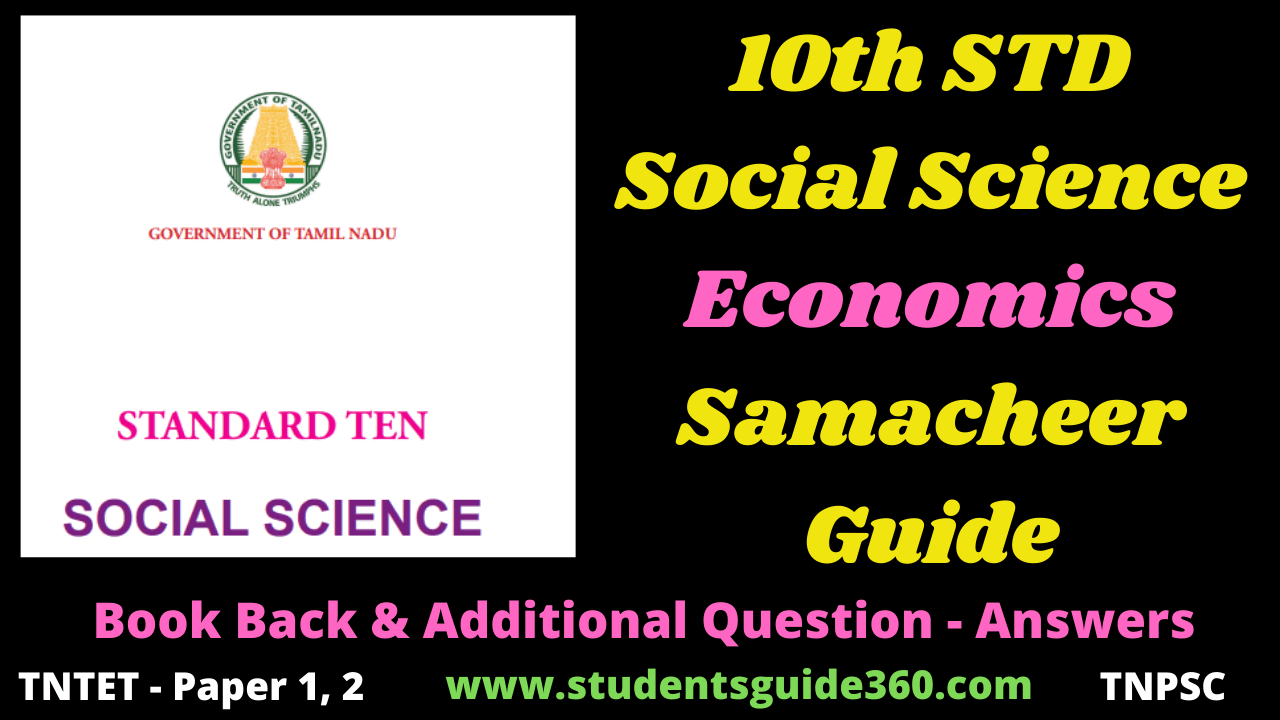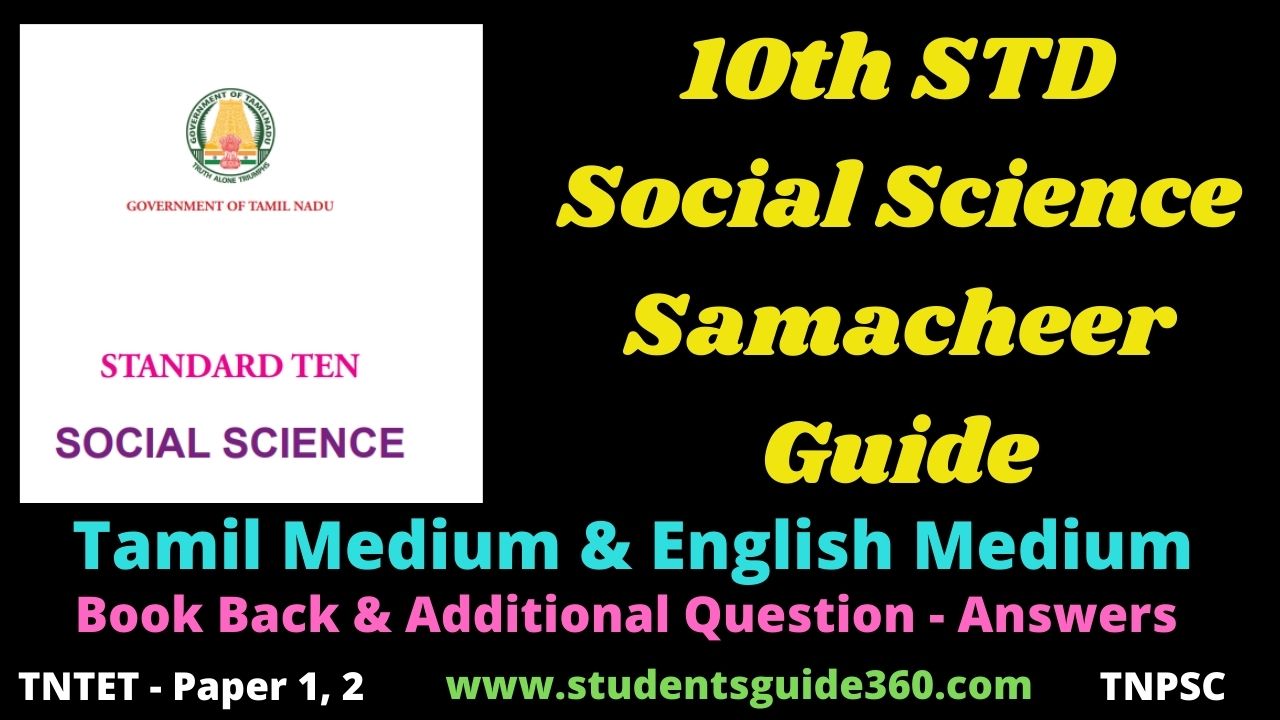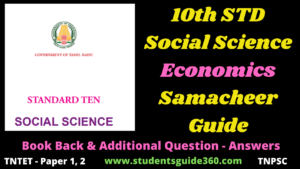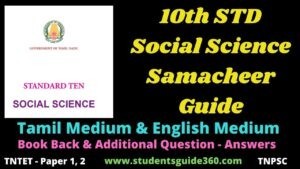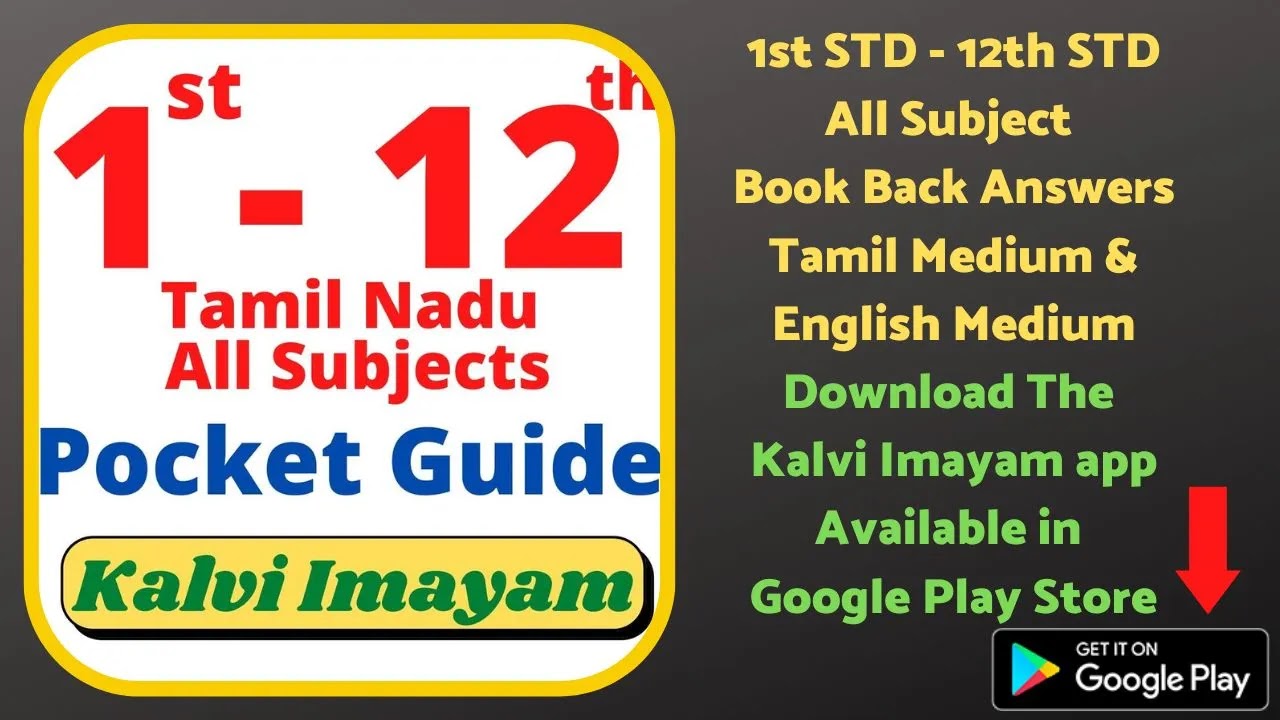10th Social Science – Economics Government and Taxes
10th Std Social Science Book back Answers | Lesson.26 Government and Taxes
10th Social Science – Economics Government and Taxes. 10th Standard Social Science Book Back Answers Tamil Medium and English Medium. SSLC History, Geography, Civics, Economics Full Answers Both School Students, TNTET, TRB, TNPSC, etc… Applicable to everyone preparing for the exam. TN Samacheer Kalvi Guide for 10th Standard. Tamil Nadu State Board Samacheer Kalvi 10th Social Science Book Answers Solutions Guide Pdf Free Download in English Medium and Tamil Medium are part of Samacheer Kalvi 10th Books Solutions. TN State Board New Syllabus Samacheer Kalvi 10th Std Social Science Guide Text Book Back Questions and Answers all units 10th Social Science Model Question Papers 2020-2021 English & Tamil Medium. We Update TN State Board Syllabus Guide All Classes Guide, Answers https://www.studentsguide360.com/
10th Social Science – Economics Government and Taxes
I. Choose the Correct Answer:
1. The three levels of government in India are ________
- Union, state and local
- Central, state and village
- Union, municipality and panchayat
- None of the above
Ans : Union, State and Local
2. In India, taxes are including ________
- Direct taxes
- Indirect taxes.
- Both (a) and (b)
- None of these
Ans : Both (a) and (b)
3. Which is the role of government and development policies?
- Defence
- Foreign policy
- Regulate the economy
- all of above
Ans : All of above
4. The most common and important tax levied on an individual in India is ______
- Service tax
- Excise duty.
- Income tax
- Central sales tax
Ans : Income tax
5. Under which tax one nation, one uniform tax is ensured ________
- Value added tax (VAT)
- Income tax
- Goods and service tax
- Sales tax
- Ans : Goods and Service Tax (GST)
6. Income tax was introduced in india for the first time in the year ________.
- 1860
- 1870
- 1880
- 1850
Ans : 1860
7. ________ tax is charged on the benefits derived from property ownership.
- Income tax
- Wealth tax
- Corporate tax
- Excise duty
Ans : Wealth Tax
8. What are identified as causes of black money?
- Shortage of goods
- High tax rate
- Smuggling
- All of above
Ans : All of above
II. Fill in the blanks:
- ________ is levied by government for the development of the state’s economy. Ans : Tax
- The origin of the word ‘tax’ is from the word ________. Ans : Taxation
- The burden of the ________ tax cannot be shifted to others. Ans : Direct
- The Goods and Service Tax act came into effect on ________. Ans : 1 July 2017
- The unaccounted money that is concealed from the tax administrator is called ________.
Ans : Black money
III. Choose the correct statement:
1. Which of the following statement is correct about GST?
(i) GST is the ‘one point tax’.
(ii) This aims to replace all direct taxes levied on goods and services by the Central and State governments.
(iii) It will be implemented from 1 July 2017 throughout the country.
(iv) It will unified the tax structure in India.
a.(i) and (ii) are correct
b.(ii), (iii) and (iv) are correct
c.(i), (iii) and (iv) are correct
d.All are correct
Ans : a, c and d are correct
IV. Match the following:
- Income Tax – Value added tax
- Excise duty – 1 July 2017
- VAT – Smuggling
- GST – Direct tax
- Black money – Indirect tax
Ans : 1 – D, 2 – E, 3 – A, 4 – B, 5 – C
V. Give a short answer:
1. Define tax
Taxation is a means by which governments finance their expenditure by imposing charges on citizens and corporate entities.
2. Why do we pay tax to the government ?
- The leving of taxes aims to raise, revenue to fund governance or to alter prices in order to affect demand.
- States use the money for carrying out many functions.
- Some of these include expenditures on economic infrastructure (transportation, sanitation, public safety, education, healthcare system, military, scientific research, culture and arts, public works, public insurance and for the operation of government itself.
3. What are the types of tax? Give examples
There are two types of taxes, direct tax and Indirect tax.
Direct Tax
Direct tax is a tax paid directly to the Union government or to state or local governments, such as Income tax, property tax and corporate tax.
Indirect Taxes
- If the burden of the tax can be shifted to others, it is an indirect tax.
- Some indirect taxes are stamp duty, entertainment tax, excise duty and goods and services tax
4. Write short note on Goods and Services Tax.
- The Goods and services tax (GST) is one of the indirect taxes.
- Goods and services tax is levied when a consumer buys a good or service.
- That aims to replace all indirect taxes levied on goods and services by the central and state governments.
- GST would eliminative the cascading effect of taxes on the production and distribution of goods and services.
- It is also a ‘one-point tax”.
5. What is progressive tax?
- Progressive tax rate is one in which the rate of taxation increases (multiplier) as the tax base increases (multiplicand)
- The amount of tax payable is calculated, by multiplying the tax base with the tax rate.
- In the case of a progressive tax, the multiplicand (Income) increases.
- When income increases, the tax rate also increases.
- This is known as a progressive tax.
6. What is meant by black money?
- Black money is funds earned on the black market on which income and other taxes have not been paid.
- The unaccounted money that is concealed from the tax administrator is called black money.
7. What is tax evasion?
- Tax evasion is the illegal evasion of taxes by individuals, corporations and trusts.
- Tax evasion often entails taxpayers deliberately misrepresenting the true state of their affairs to the tax authorities to reduce their tax liability. It includes dishonest tax reporting, such as declaring less income, profits or gains than the amounts actually earned, or overstating deductions.
8. What is the difference between tax and payments?
| Tax | Payments |
| 1. Tax is compulsory to the government without getting any direct benefits | Fee is the payment for getting any service |
| 2. If the element of revenue for general purpose of the state predominates, the levy becomes a tax | While a fee is a payment for a specific benefit privilege although the special to the primary purpose of regulation in public interest. |
| 3. Tax is a compulsory payment | Fee is a voluntary payment. |
| 4. If tax is imposed on a person, he has to pay it; otherwise he has to be penalised | On the other hand fee is not paid if the person do not want to get the service |
| In this case, tax payer does not expect any direct benefit. | Fee payer can get direct benefit for paying fee. |
| Example: Income tax, gift box, wealth tax, VAT etc. | Examples: stamp fee, driving license fee, government registration fee |
VI. Brief Answer
1. Explain some direct and Indirect taxes.
Direct Taxes :
- A tax imposed on an individual or Organisation, which is paid directly, is a direct tax.
- The burden of a direct tax cannot be shifted to others.
- Some direct taxes are income tax, wealth tax and corporation tax.
- Income tax:
- Income tax is the most common and most important tax levied on an individual in
- It is charged directly based on the income of a person.
- The rate at which it is charged varies, depending on the level of income.
- Corporate tax:
- This tax is levied on companies that exist as separate entities from their shareholders.
- it is charged on royalties, interest gains from sale of capital assets located in India and fees for a technical services and dividends.
- Foreign companies are taxed on income that arises or is deemed to arise in India.
- Wealth tax :
- Wealth tax is charged on the benefits derived from property ownership.
- The same property will be taxed every years on its current market value.
- The tax is levied on the individuals and companies alike.
Indirect Taxes
- If the burden of the tax can be shifted to others, it is an indirect tax.
- The impact is on one person while the incidence is on the another person.
- Therefore, in the case of indirect taxes, the tax payer is not the tax bearer.
- Some indirect taxes are stamp duty, entertainment tax, excise duty and goods and service tax (GST).
- Stamp duty:
Stamp duty is a tax that is paid on official documents like marriage registration or documents of property and in some contractual agreements.
- Entertainment tax :
- Entertainment tax is a duty that is charged by the government on any source of entertainment provided.
- This tax can be charged on movie tickets, tickets to amusement parks, exhibitions and even sports events.
- Excise duty :
- An excise tax is any duty on manufactured goods levied at the movement of
- manufacture, rather than at sale.
- Excise is imposed in addition to an indirect tax such as a sales tax.
2. Write the structure of GST
State Goods and services Tax (SGST): Intra state (within the state)
VAT /Sales tax, purchase tax, entertainment tax, luxury tax, lottery tax and state surcharge and cesses.
Central Goods and services Tax (CGST): Intra state (with the state)
Central Excise Duty, Service tax, countervailing duty, additional duty of customs, Surcharge, education and secondary /higher secondary cess.
Integrated Goods and services Tax (IGST): Interstate (integrated GST)
- There are four major GST rates : 5 %, 12 %, 18 %,and 28 %.
- Almost all the necessities of life like vegetables and food grains are excempted from this tax.
3. What is black money? Write the causes of black money.
Black money is funds earned on the black market on which income and other taxes have not been paid.
The unaccounted money that is concealed from the tax administrator is called black money
Causes of Black money :
Several sources of black money are identified as causes.
- Shortage of goods :
- Shortage of goods, whether natured or artificial, is the root cause of black money.
- Controls are often introduced to check black money.
- Licensing proceeding :
It is firmly believed that the system of controls permits, quotes and licences are associated with maldistribution of commodities in short supply, which results in the generation of black money.
- Contribution of the industrial sector :
- Industrial sector has been the major contributor to black money.
- For example, the Controller of Public Limited Companies tries to buy commodities at low prices and get them billed at high amounts and pockets the difference personally.
- Smuggling :
- Smuggling is one of the major sources of black money.
- When India had rigid system of exchange controls, precious metals like gold and silver, textiles and electronics goods were levied a heavy excise duty.
- Bringing these goods by evading the authorities is smuggling.
- Tax structure :
- When the tax rate is high, more black money is generated.

